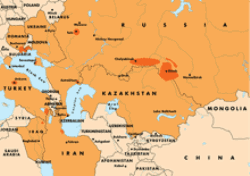It is the World Health Organization's oldest -- and still key -- affiliate facility, the World Influenza Center (WIC).
Dr. Sir John Skehel heads the National Institute for Medical Research (NIMR) complex, of which the center is part.
He proudly points out that the reason the WHO relies on the British center to do the crucial bird-flu virus work is that this laboratory is actually where the whole global WHO network begun half-a-century ago.
"We started the whole network in 1947 from this laboratory on behalf of the WHO, so the World Influenza Center at the NIMR has been at the center of the World Health Organization influenza surveillance since it started at the beginning," Skehel says.
Skehel explains that his institute identified the influenza virus in 1933, also introducing the vaccine in 1945. And the center has been following the development of the influenza virus ever since, adjusting the vaccine effectiveness accordingly.
Today, the WIC is one of only four key WHO collaborating centers for influenza in the world. It is also part of the influenza network of 112 national influenza centers in 83 countries that form the Global Surveillance Network.
The WIC focuses on early detection of new influenza types with the potential to cause a pandemic, and it has been involved with bird flu since the first infections in Hong Kong in 1997. It specializes in monitoring genetic changes in the virus, as well as advising on best vaccines. As for the volume of work, the center produces about 1,500 genetic maps of viruses a year as it receives samples from some 50 countries.
The World Health Organization is full of praise for the London laboratory, especially with the most recent genome mapping of Turkish bird flu samples.
"WHO collaborating centers are of a top quality," says Christine McNab, a spokeswoman for the WHO at its headquarters in Geneva, Switzerland. "Especially for this kind of work when the genomic sequencing getting clear accurate results is so important. We would leave that to a laboratory that could deliver this kind of results, and, obviously, we have full confidence in our laboratory in London."
McNab explains that the London laboratory on 12 January confirmed that -- apart from a small mutation that has been already spotted -- the Turkish bird-flu outbreak appears to have been caused by a virus that has not mutated sufficiently to transfer from human to human.
Skehel also stresses that the observed small mutation seems to be no "precursor" of any human-to-human transferability. But he says it remains to be seen what that small mutation does signify.
"We recovered viruses from both of the samples from dead children that we received," Skehel says. "One of the samples was clearly a mixture of two viruses, and it was from one of those that the mutation was detected. Significant or otherwise – who's to say?"
Skehel stresses the slight mutation changes the properties of the virus's ability to bind to human cells. This is apparently why the virus transfers from birds to humans, but not between humans.
With a genetic map of the sample of the H5N1 virus completed, the laboratory is now to continue further testing to confirm or disprove any mutation trends in other samples from Turkey.
But as the laboratory in London receives and examines dangerous viruses from around the world, is there any danger that some of them might leak out to infect the very publics the laboratory is trying to protect?
Skehel says there is nothing for people to fear.
"The laboratory is the highest containment laboratory that you can make and, from that point of view, nothing will come out except completely inactivated material," Skehel says. "So, I think, they can be reassured about that."
Christine McNab of the WHO says that as the London laboratory tries to solve the mysteries of bird flu, there are some ways in which people in East Europe and Central Asia can both protect themselves against the disease and help the laboratory do its work.
"The virus has spread from Asia to Turkey, to Ukraine previously, through migratory birds," McNab says. "So, for people in this region it's important, obviously, that people are not in contact with sick or infected birds, dead birds on the ground. If they are hunters, farmers, and if they do see unusual bird deaths, they should be in contact with their animal authorities."
McNab concludes that such steps would help stop further bird flu cases, and be useful for monitoring the spreading of the disease. And they could also help get samples for testing to the world's best and most experienced laboratories, such as the World Influenza Center in London.
Affected Areas

Click on the map for a closer view of the areas within RFE/RL's broadcast region where cases of diseased fowl have been confirmed. Last updated on February 20.
BIRD FLU, or avian influenza, continues to menace scattered areas from East Asia, where the disease first appeared, to Southeastern and Eastern Europe and beyond. Authorities around the world are bracing themselves -- and, more importantly, planning and taking measures to fight the disease wherever it appears.
Stories Of Particular Interest:
Bird-Flu Expert Discusses Issue Of Migratory Birds
Bird Flu: As European Worries Grow, Some See Benefits In Alarm



